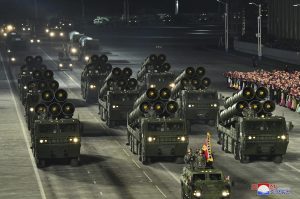North Korea held a military parade to commemorate the ruling Workers’ Party’s Eighth Congress, with leader Kim Jong Un in attendance, on the evening of January 14. This is the first time that North Korea has held a military parade to commemorate a Party Congress.
North Korea’s state media reported on January 15 that the country’s military parade was held at Kim Il Sung Square in the capital Pyongyang the previous day. According to sources from the South Korean government, the military parade began between 6 p.m. and 7 p.m.
North Korea had held military parade rehearsals at night for several days in the lead-up to the parade proper. The timing, under cover of darkness, would make it more difficult for South Korea and the United States – which are conducting close monitoring of North Korea’s military maneuvers – to analyze the weapon systems on display.
The nighttime military parade was the second of its kind, following a military parade marking the 75th anniversary of the Workers’ Party in October of last year. Considering North Korea had held a military parade just three months ago, yesterday’s was meant to demonstrate Kim’s strong will to advance nuclear capabilities as he vowed during the Congress last week, according to experts.
Strategic and tactical weapons including submarine-launched ballistic missiles (SLBMs) appeared at the military parade. However, for the first time in recent memory, the event did not feature an intercontinental ballistic missile (ICBM).
It will take more time to analyze what the North introduced in terms of its advanced missiles, as it has not released a video of the military parade yet.
According to photos of the military parade released by North Korea’s Korean Central News Agency, or KCNA, several SLBMs appeared in mobile launch vehicles with the label “Pukkuksong-5” (Pukkuksong means “North Star” in Korean). That is presumed to be a new advanced version of the SLBM known as Pukkuksong-4, which was unveiled at the last military parade.
Most of the North’s new weapons development plans have significant technical difficulties in their early stages and take a long time to reach operational status. Given that, experts theorized that Pukkuksong-5 is likely to be a model, rather than an operational missile, as it does not seem to be much different from Pukkuksong-4. Experts also believe that revealing the writing – Pukkuksong-5 – on the outside of the missile was a purposeful signal of North Korea’s advances in SLBM technology.
The KCNA specifically mentioned “underwater strategic ballistic missiles,” the North Korean name for an SLBM, referring to it as the world’s best weapon. KCNA said the underwater missiles can firmly uphold the North’s military and technological strength and overwhelm the world.
The newly unveiled SLBM was almost the same body length as the Pukkuksong-4, but the warhead is believed to be longer, raising the possibility that the missile can carry multiple warheads or has an extended range. Some experts raised the possibility that the missile on display on the parade was the same SLBM known as Pukkuksong-3, first launched by North Korea on October 2, 2019, which has never actually appeared in a military parade.
An improved version of Iskander, or KN-23, a short-range ballistic missile, also appeared for the first time at the military parade. Compared to the KN-23 that was previously unveiled the missile shape has become sharper and the wheels of the mobile vehicles carrying the missiles are larger. The KN-23, with a range of around 400 to 600 kilometers, is considered a tactical missile aimed at South Korea. Military experts say it could be difficult to intercept with South Korea’s missile defense system.
Notably, however, KCNA did not release any pictures of the Hwasong-15, an intercontinental ballistic missile capable of reaching the U.S. mainland, from the January 14 parade.
During the Congress last week, North Korea said it will focus on strengthening its military capabilities, disclosing its plans to develop nuclear submarines and ultra-high-speed weapons in the party’s report.
North Korea has long wanted the international community, especially the United States, to recognize its status as a nuclear power and Kim repeatedly mentioned “nuclear power” several times at the Congress. The display of weaponry at the parade is likely a demonstration of North Korea as a de facto nuclear power, meant to strengthen Pyongyang’s position in any future negotiations with the U.S. or South Korea. However, Kim did not make a speech at the parade and there was no direct mention of the United States.
For the incoming Biden administration in the United States, denuclearization negotiations with North Korea will be immensely difficult.
“Despite North Korea’s financial weaknesses, it would be a mistake to read Kim Jong Un’s nuclear weapons ambitions as mere bluster ahead of Biden’s inauguration. With its growing military capabilities, Pyongyang will be more difficult to deter and negotiate with in the New Year,” Leif-Eric Easley, a professor at Ewha University in Seoul, told The Diplomat.
With the end of the military parade, the country finally completed the Party Congress, one of its most important political events. The entire Congress lasted eight days from its beginning on January 5.

































